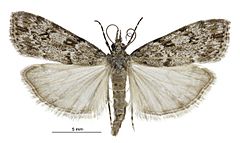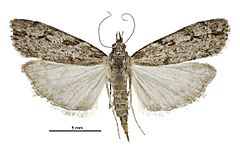Eudonia cymatias facts for kids
Quick facts for kids Eudonia cymatias |
|
|---|---|
 |
|
| Male | |
 |
|
| Female | |
| Scientific classification | |
| Kingdom: | |
| Phylum: | |
| Class: | |
| Order: | |
| Family: | |
| Genus: |
Eudonia
|
| Species: |
E. cymatias
|
| Binomial name | |
| Eudonia cymatias (Meyrick, 1884)
|
|
| Synonyms | |
|
|
The Eudonia cymatias is a small, fascinating moth that belongs to the Crambidae family. It was first described by a scientist named Edward Meyrick in 1884. This special moth can only be found in one place in the world: New Zealand.
Contents
Discovering the Eudonia cymatias Moth
The Eudonia cymatias is a type of insect that flies at night, just like butterflies. Moths and butterflies are part of a large group called Lepidoptera. This group is known for its scaly wings.
Who Discovered It?
The person who officially named and described this moth was Edward Meyrick. He was a very important entomologist, which is a scientist who studies insects. He described this moth in 1884, giving it its scientific name.
Where Does It Live?
This moth is endemic to New Zealand. This means it naturally lives only in New Zealand and nowhere else on Earth. New Zealand is famous for its unique plants and animals, many of which are endemic. This makes the Eudonia cymatias a special part of New Zealand's natural heritage.
What Does the Eudonia cymatias Look Like?
The Eudonia cymatias moth is quite small. Its wingspan, which is the distance from one wingtip to the other when the wings are spread out, is about 21 to 22 millimeters. That's roughly the width of a small coin!
Wing Colors and Patterns
The front wings, called forewings, are mostly a dark, grayish-brown color. This color is called fuscous grey. They also have a mix of white and tiny black speckles, which scientists call "irrorated with black." These patterns help the moth blend in with its surroundings.
The back wings, or hindwings, are a lighter color. They are a pale whitish-grey. Sometimes, they might have a slight yellowish-brown tint, which is called ochreous. There's also a darker grey line near the outer edge of the hindwings.
When Can You See This Moth?
Adult Eudonia cymatias moths have been seen flying around in January. This means that January is likely the time of year when these moths are most active. They are flying, looking for mates, and laying eggs to continue their life cycle.
Like many moths, the Eudonia cymatias likely goes through different life stages. It starts as an egg, hatches into a larva (a caterpillar), then forms a pupa, and finally emerges as an adult moth.

